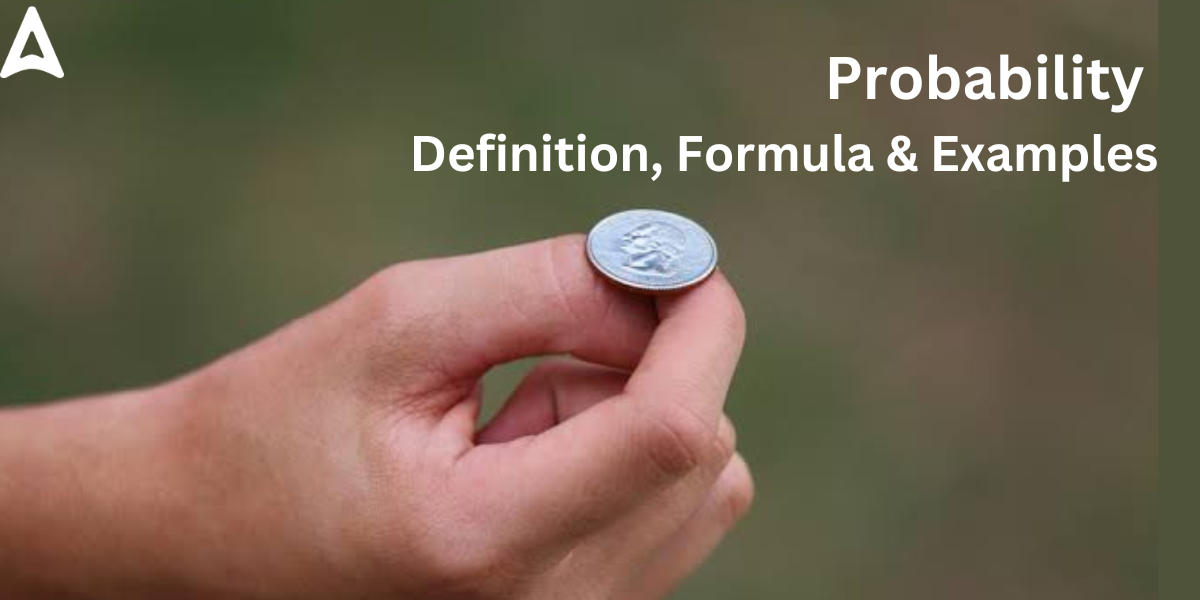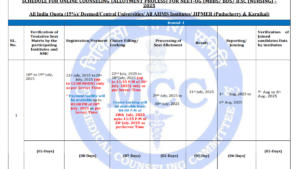Probability Formula: We frequently heard the word “probability” mentioned in the commentary while watching a football or cricket game. In Statistics, Probability describes the likelihood of an event happening. There are numerous real-life scenarios in which we must forecast the outcome of an occurrence. Probability has numerous uses in gaming, business to make forecasts, and in this emerging area of artificial intelligence. Using the Probability Formula, one can calculate the likelihood of an event by dividing the favorable outcome by the total number of alternative outcomes. In this article, we are going to learn about the Probability Formula and its various forms with examples.
What is Probability Definition?
Probability is defined as the ratio of the number of positive outcomes to the total number of outcomes of an event. When we consider a random experiment, one of the first queries that come to mind is, “What are the consequences of the experiment?”Here probability defines the possibility of forecasting an occurrence.
Though probability began with gambling, it is now widely employed in a range of fields such as Physical Sciences, Commerce, Biological Sciences, Medical Sciences, Weather Forecasting, and so on. To completely grasp the concept, students must be familiar with a range of probability formulas.
What is Probability Formula in Maths?
The probability formula calculates the chances of an upcoming event. The probability formula is nothing but the ratio of the number of positive outcomes to the total number of outcomes.The number of good outcomes for an experiment with ‘S’ outcomes is denoted by R. The following probability formula is used to calculate the likelihood of an event.
Event Probability = Favorable Outcomes/Total Outcomes = R/S
Things to keep in Mind:
- The probability of an event occurring can range between 0 and 1. i.e. 0 ≤ P(A) ≤ 1
- The probability of a certain event or sure event is 1. i.e. P(E) = 1
- The probability of an improbable occurrence is 0. i.e. P(E) = 0
Basic Probability Formula
The possibility of an event occurring is determined by the probability formula. It is the proportion of successful results to all successful outcomes. The probability formula can be used to calculate the likelihood of an event by dividing the favorable number of possibilities by the total number of options. The probability formula is represented as follows:
Probability of Event to Happen P(E) = Number of Favourable Outcomes/Total Number of Outcomes
i.e., P(E) = n(A)/n(S)
where,
- P(A) = The probability of an event ‘E’.
- n(A) = a number of favorable outcomes of an event ‘E’.
- n(S) = total number of events occurring in a sample space.
Probability Formulas for Class 10 and 12
To Find out the possibility of the occurrence of a certain event( Assume A and B are two events). , We may use the probability formula in different forms as listed below.
| Probability formulas Class 10 and 12 | |
| Probability formula of addition | P(A ∪ B) = P(A) + P(B) – P(A∩B) |
| Range of Probability | 0 ≤ P(A) ≤ 1 |
| Probability formula for complementary events | P(A’) + P(A) = 1 |
| Probability formula If two other occurrences connect with one another, |
|
| Probability formula for Disjoint Events | P(A∩B) = 0 |
| Probability Formula for Conditional Events |
P(A | B) = P(A∩B) / P(B)
|
Conditional Probability Formula
The chance of an event occurring given that another event has already occurred is known as conditional probability. In other words, this formula determines the chance of event A occurring if event B has already occurred, and it is the ratio of the probability of both events A and B occurring to the probability of event B occurring.
The conditional probability formula is:
P(A∣B)=P(B)P(A∩B)
Where:
- P(A∣B) is the conditional probability of event A occurring given that event B has occurred.
- P(A∩B) is the probability of both events A and B occurring.
- P(B) is the probability of event B occurring.
Remember that for this conditional probability formula to function, P(B) must be greater than zero, indicating that the event B has a non-zero probability of occurring. The formula becomes ambiguous if P(B)=0.
All Probability Formulas
All of the probability formulas that are often employed in statistics and probability theory are listed below:
- Probability of an Event A:
P(A)=Total Number of Possible OutcomesNumber of Favorable Outcomes
- Complementary Probability:
P(not A)=1−P(A)
- Probability of the Union of Two Events (A or B):
P(A∪B)=P(A)+P(B)−P(A∩B)
- Probability of the Intersection of Two Events (A and B):
P(A∩B)
- Conditional Probability of A given B:
P(A∣B)=P(B)P(A∩B)
- Multiplication Rule for Independent Events:
If events A and B are independent, then P(A∩B)=P(A)⋅P(B)
- Bayes’ Theorem:
P(A∣B)=P(B)P(B∣A)⋅P(A)
- Law of Total Probability:
If B1,B2,…,Bn form a partition of the sample space, then for any event A:
P(A)=∑i=1nP(A∣Bi)⋅P(Bi)
- Expected Value (Mean):
E(X)=∑x⋅P(X=x) (for discrete random variables)
E(X)=∫x⋅f(x)dx (for continuous random variables)
- Variance:
Var(X)=E((X−μ)2)
Var(X)=∑(x−μ)2⋅P(X=x) (for discrete random variables)
Var(X)=∫(x−μ)2⋅f(x)dx (for continuous random variables)
- Binomial Distribution:
P(X=k)=(kn)⋅pk⋅(1−p)n−k
- Standard Deviation:
σX=Var(X)
- Exponential Distribution:
f(x)=λe−λx
- Poisson Distribution:
P(X=k)=k!e−λ⋅λk
- Normal Distribution (Gaussian Distribution):
f(x)=σ2π1e−21(σx−μ)2
Terminology used in Probability formula
In Class 10 Mathematics, Probability is a crucial chapter for students because it discusses all of the fundamental principles. It has been discovered that pupils may struggle to understand the Probability formula. We must understand a few key phrases or become acquainted with the terminology linked with the Probability formula.
- Experiment: An experiment is any specific condition or incident for which we must determine the probability. Some phenomena include dice rolling, coin tossing, drawing a card from a well-shuffled deck, and so forth.
- Outcome: The outcome of any occurrence, such as the number on a dice, the side of a coin, a drawn card, and so on.
- Sample Space: The set of all conceivable findings or outcomes is referred to as the sample space. This suggests that there is no likelihood of any other result occurring. Whatever the outcome, it will be based on this sample Space.
Examples of Sample Spaces:
A coin is tossed = Event
E1 = Getting a head (H) on upper face
E2 = Getting a tail (T) on upper face
S = {H, T}
Total number of outcomes = 2
Two coins are tossed = Event = E
E1 = Getting a head on coin 1 and a tail on coin 2 = (H, T)
E2 = Getting a head on both coin 1 and coin 2 = (H, H)
E3 = Getting a tail on coin 1 and a head on coin 2 = (T, H)
E4 = Getting a tail on both, coin 1 and coin 2 = (T, T)
S = {(H, T), (H, H), (T, H), (T, T)}.
Total number of outcomes = 4
- Favorable outcome: An incident that has led to the desired result or an anticipated event
Probability Function: The function aids in determining the likelihood of each possible occurrence. - Event: The sum of all conceivable results of an experiment, such as receiving heads or tails on a tossed coin, an even or odd number on dice, and so on.
- Equally Likely Events: Equally likely events are those that have the same likelihood of occurring. One event’s consequence is unrelated to
- Exhaustive Events: We refer to an event as being exhaustive when the set of all possible outcomes is equal to the sample space.
- Mutually exclusive Events: Events that cannot occur simultaneously are referred to as mutually exclusive events. We cannot experience hot and cold weather at the same time.
Key Facts:
- Coin: A coin has two faces termed as Head and Tail.
- Dice: A dice is a small cube which has between one to six spots or numbers on its sides, which is used in
games. - Cards: A pack of playing cards consists of four suits called Hearts, Spades, Diamonds and Clubs. Each
suite consists of 13 cards.
Events in Probability
An event in probability theory is a set of experiment results or a subset of the sample space., Theoretical probability associated with an event E is defined as “If there are ‘n’ elementary events
associated with a random experiment and m of these are favourable to the event E then the probability of
occurrence of an event is defined by P(E) as
- If P(E) = 1, then it is called a ‘Certain Event’.
- If P(E) = 0, then it is called an ‘Impossible Event’.
- The probability of an event E is a number P(E) such that: 0 ≤ P(E) ≤ 1
An basic event is one that has only one outcome. The total of all the probability of an experiment’s elementary events is 1.
For any event E, P(E) + P(E¯) = 1, where E¯ stands for ‘not E’. E and E¯are referred to as complimentary events.Favourable outcomes in the sample space are those that are favorable to the occurrence of an event.
If we are given two occurrences, “A” and “B,” the probability of event A, P(A), will be greater than the probability of event B if and only if event “A” is more likely to occur than event “B.” The set of all possible outcomes of an experiment is represented by sample space(S), and the number of outcomes in the sample space is represented by n(S).
P(E) = n(E)/n(S)
P(E’) = (n(S) – n(E))/n(S) = 1 – (n(E)/n(S))
E’ denotes that the event will not take place.
As a result, we may now derive that P(E) + P(E’) = 1.
How to Calculate Probability for Class 10, 12 Students?
Using the probability formula, you can easily find out the chances of an occurrence in an experiment that the event will occur. As per the theory of probability, Any event’s probability is a number between (and including) “0” and “1”. Check out the easy steps to determine an event’s probability using the Probability formula.
Step 1: Navigate the experiment’s sample area and count the components. Indicate it with n(S).
Step 2: Determine the number of favorable outcomes and represent it as n(A).
Step 3: As per the Probability formula, divide n(A) by n(S) to find probability. P(A) = n(A)/n(S).
Probability Formulas Based Examples for Class 10 & 12
Check out some solved Examples based on the probability Formula and its concept:
Example 1: When two dice are thrown, determine the probability of getting a sum of 7?
Solution: When we throw two dice, we have a total of 36 choices.
To get the desired result, 7, we can have the following positive results.
Fovarable Outcomes to get 7 aare = (4,3),(3,4),(2,5)(5,2),(1,6)(6,1)
There are six favorable results.
P(E) = (Number of favorable outcomes) (Total outcomes in a sample space) Probability of an event
The probability of receiving the number 7 is 6/36 = 1/6.
As a result, the probability of achieving a sum of 7 is 1/6.
Example 2: Determine the likelihood of rolling a dice and getting an even number.
Solution: Sample space (S) = 1, 2, 3, 4, 5, 6, 7.4, 5, 6}
Number of Favorable Events = n(S) = 6
Let “E” represent the event of receiving an even number, E = 2, 4, 6
Number of Desirable Events = n(E) = 3
As per the probability formula, the chance of getting an even number is calculated as follows
P(E) = (Number of outcomes favorable)/(Total number of outcomes)
= n(E)/n(S)
= 3/6
= 1/2
Example 3. Which of the following statement is incorrect?
(a) Probability of an event lies between 0 and 1.
(b) Probability of an impossible event is 1 and that of a sure event is 0.
(c) Probability is the measure of the chance of an event happening.
(d) None of these
Ans.(b)
Sol. correct statement ⟹ Probability of an impossible event is 0 and that of a sure event is 1.
Example 4. A bag contains 3 white, 2 blue and 5 red balls. One ball is drawn at random from the bag. What is the probability that the ball drawn is not red?
(a) 1/2
(b) 4/5
(c) 3/10
(d) 1/5
Sol. P (a) = 𝐹𝑎𝑣𝑜𝑢𝑟𝑎𝑏𝑙𝑒 𝑜𝑢𝑡𝑐𝑜𝑚𝑒𝑇𝑜𝑡𝑎𝑙 𝑜𝑢𝑡𝑐𝑜𝑚𝑒 =5/10=1/2
Ans.(a)









 NEET UG 2025 Counselling Dates OUT! Chec...
NEET UG 2025 Counselling Dates OUT! Chec...
 Dr MGR Medical University Results 2025 R...
Dr MGR Medical University Results 2025 R...
 GSEB HSC Science Supply Result 2025 Down...
GSEB HSC Science Supply Result 2025 Down...









